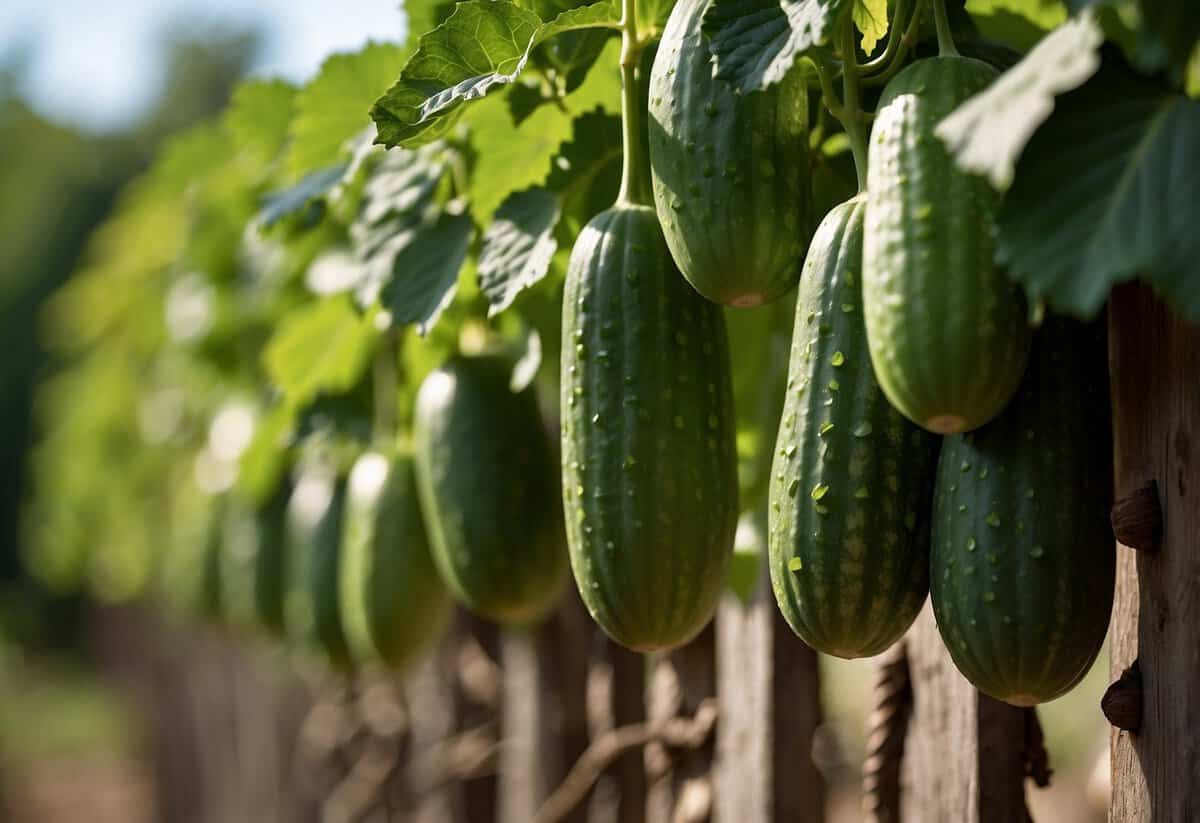Cucumber Garden Tips: Boost Your Harvest Easily
Growing cucumbers in your garden can be a joyful and rewarding experience. Whether you’re a beginner or seasoned gardener, there’s always something new to learn about these crunchy, refreshing fruits. Cultivating healthy cucumber plants involves more than just planting seeds in the ground and waiting for them to grow.

What are some essential tips to ensure your cucumbers thrive in your garden? This article will explore various techniques and recommendations to help you harvest plentiful, delicious cucumbers all season long. From preparing your soil to managing pests, you’ll discover key strategies to get the most out of your cucumber garden.
1) Choose the Right Cucumber Variety

When starting your cucumber garden, picking the right variety is crucial. Cucumbers come in two main types: slicing and pickling. Slicing cucumbers, like ‘Marketmore’ and ‘Straight Eight,’ are great for fresh eating. Pickling cucumbers, such as ‘Boston Pickling’ and ‘National Pickling,’ are perfect for preserving.
Consider the space in your garden. Some cucumber varieties, like ‘Bush Champion,’ are compact and suited for small gardens or containers. Others, like ‘Spacemaster,’ are good for limited spaces as well.
Think about your climate. Some cucumbers, including ‘Northern Pickling,’ are better for cooler climates. Warm regions can try heat-tolerant types like ‘Poinsett 76’ for best results.
2) Plant in Full Sun

Cucumbers thrive when they get plenty of sunlight. Make sure you plant them in an area where they can receive at least six to eight hours of direct sunlight every day.
Full sun not only helps cucumbers grow faster but also ensures they produce more fruit. When planning your garden, pick a sunny spot where shadows from buildings or trees won’t block sunlight. Be sure to check local guidelines and conditions to optimize your cucumber growth.
3) Use Well-Draining Soil

Cucumbers thrive in well-draining soil. Waterlogged conditions can cause root rot. To prevent this, mix garden soil with well-aged compost or aged manure. Adding perlite, vermiculite, or sand to the soil improves its drainage.
Test your soil’s pH levels. Cucumbers prefer a pH range of 6.5 to 7. Avoid heavy, compacted soil. Loose, nutrient-rich soil promotes healthy cucumber growth.
4) Space Plants Adequately

Proper spacing is crucial for your cucumber plants. For bush varieties, space them 18-24 inches apart in rows 3-4 feet apart.
Vining varieties need more room. Place them 36-48 inches apart in rows 5-6 feet apart.
Good spacing helps each plant get enough sunlight and air. This helps keep diseases away and boosts growth.
Learn more about cucumber plant spacing.
5) Provide Trellis Support

Giving your cucumber plants trellis support is super helpful. Using welded wire fencing is a strong and durable option. This kind of fencing allows cucumber vines to latch on quickly. You can install it using metal T-stakes or wood stakes.
An A-frame trellis is also a great choice. It’s sturdy and can be made from materials like reclaimed wood or bamboo.
Growing cucumbers vertically helps in boosting fruit production. It also keeps the leaves dry, which reduces the risk of disease. Try these methods to make the most of your garden space.
6) Water Consistently

Cucumbers need regular watering to grow strong and healthy. Aim to keep the soil evenly moist. Water when the top 1-2 inches are dry.
Morning is the best time to water. This prevents fungus and allows the plants to absorb water before it gets too hot.
Using a soaker hose or drip system helps deliver water directly to the roots and reduces evaporation.
7) Mulch Generously

Using mulch around your cucumber plants can really help them grow strong. Popular choices include straw, grass clippings, shredded leaves, or compost. These materials help keep the soil moist and prevent weeds from competing with your cucumbers.
Apply mulch to a depth of about 2-3 inches. Make sure to leave a small gap around the base of each plant to avoid moisture buildup and potential stem rot. Mulching also improves soil quality over time by adding organic matter as it breaks down.
8) Fertilize Regularly

You should start fertilizing cucumbers about two weeks after planting the transplants. Use a light dose of liquid fertilizer every two weeks throughout the growing season.
When the cucumber plants begin to flower, switch to a fertilizer high in potassium. This helps the plants produce more flowers and fruits. Use a liquid fertilizer mixed with water for best results.
For young cucumber plants, choose a balanced granular fertilizer such as a 10-10-10 or 15-15-15 mix. This will support leaf and stem growth.
9) Monitor for Pests

Check your cucumber plants regularly for pests.
Aphids often hide on the underside of leaves and can be green, yellow, or even black. If you notice them, use insecticidal soap to manage them.
Flea beetles are another common issue. You can protect your plants with floating row covers or use insecticidal soap if beetles are spotted.
Inspecting your plants helps catch problems early, before they become serious.
10) Harvest Frequently

Picking cucumbers often is key to getting a good harvest. When cucumbers are left on the vine too long, they can become bitter and stop the plant from producing more fruit.
Look for the right size. For regular slicing cucumbers, aim for 6 to 8 inches long. Pickling cucumbers are best at around 2 inches.
Harvesting early in the morning is ideal. The cool temperature helps keep the cucumbers crisp and fresh.
Starting Your Cucumber Garden

Getting started with your cucumber garden involves creating the best soil conditions and choosing an optimal location. Follow these steps to ensure your garden thrives.
Ideal Soil Conditions
Your cucumbers prefer soil that is well-draining and rich in organic matter. Begin with a loamy soil that retains moisture yet drains well. It’s essential to maintain a soil pH of 6.0 to 6.8 for optimal growth.
Before planting, mix in compost or aged manure to enhance soil fertility. This provides essential nutrients and improves soil structure. Ensure the soil is warm, ideally around 65°F (18°C), as cucumbers thrive in warm conditions.
To keep moisture consistent, consider adding a layer of mulch. Mulch helps retain soil moisture and suppresses weeds, giving your cucumbers a better growing environment.
Choosing the Right Location
Select a sunny spot in your garden. Cucumbers need at least 6 to 8 hours of sunlight daily to grow well. Full sun ensures they develop strong vines and produce plenty of fruit.
Make sure the location is protected from strong winds. This can be done by planting near a windbreak or using garden fencing.
Space plants properly to avoid overcrowding. Plant seeds or seedlings about 12-18 inches apart to allow ample room for growth and air circulation. Proper spacing helps prevent diseases and allows plants to access the nutrients they need.
By choosing the right soil and location, you’ll set up your cucumber garden for success.
Caring for Your Cucumber Plants

Ensuring your cucumber plants thrive means giving them proper care related to watering and fertilization. This will help you achieve a healthy and bountiful harvest.
Watering Tips
Consistently moist soil is crucial for cucumbers. Water your cucumber plants deeply once or twice a week, especially in hot weather. Use a soaker hose to keep the foliage dry and prevent diseases.
Morning watering is best, as it allows leaves to dry out during the day. This reduces the risk of mildew and other diseases. Avoid getting water on the leaves.
In especially hot weather, you might need to water more frequently. Check the soil regularly to ensure it remains moist about an inch deep. If the soil is dry at this depth, it’s time to water.
Effective Fertilization
Cucumbers benefit from regular feeding with balanced fertilizer. Use a 10-10-10 fertilizer (nitrogen-phosphorus-potassium) every four weeks during the growing season.
Before planting, mix compost or well-rotted manure into the soil. This improves soil fertility and structure.
You can also use a liquid fertilizer every two weeks once flowering begins. Be sure to follow the instructions on the fertilizer package for best results.
Too much nitrogen can cause lots of leaves but few fruits. Monitor growth and adjust your fertilization routine if necessary.







